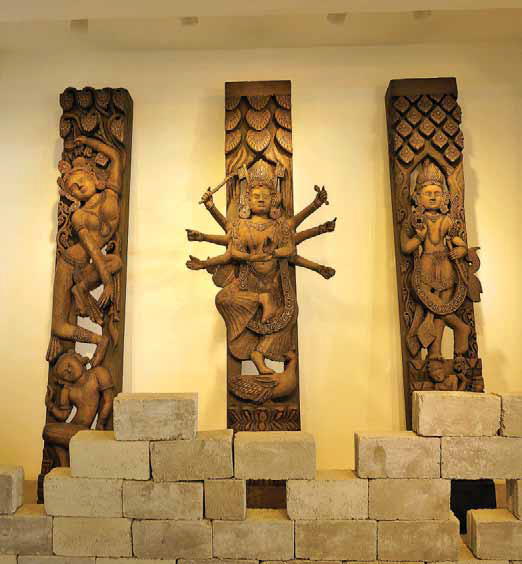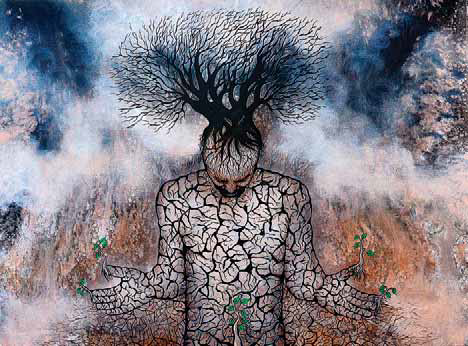WHAT IS ART? THIS IS QUESTION THAT HAS BAFFLED HUMAN BEINGS FOR
MILLENNIA. WE ARE NO CLOSER TO A DEFINITE ANSWER TODAY THAN WE
WERE WHEN PLATO FIRST CALLED ART THE IMITATION OF IMITATION.
Text: Yam Prasad Sharma
I was amongst artists, art critics and exhibition-goers at a gallery some time ago when I heard the question, “What is art?” being asked. An artist replied, “Art is the expression of feeling”, another said, “Art is conveying an idea in a beautiful manner. Still another artist stated, “Art is beauty, and beauty is art”. A critic said, “Art is a copy or representation of nature”, another responded, “Art is creativity; it creates new things”. A viewer joined in to say, “Art is nothing but play”, another stated, “Art is life”. “Everything done by human beings is art,” stated yet another visitor. One artist opposed the other, one critic criticised another. One viewer said, “All these definitions are wrong”, another responded, “All these definitions are right, and there are still more definitions of art.” This argument and debate made my head go round. I was confused and dazzled.

I began to ponder upon the question, “What is art?” I began studying aesthetics, the study of art and beauty. I attempted to explore concepts and ideas regarding art as these have been expounded from the classical era to the present. Plato, the Greek philosopher says art is the imitation of imitation; that is, this world or nature is an imitation of an ideal world, and artists imitate objects of this world that are themselves only imitations. The world we are living in is an illusion. Artists copy this illusion in their work. By this token, art is three steps away from originality. In other words, art is duplicate and false, and it leads people, especially children, toward the wrong direction. Furthermore, art is guided by passion, not by intellect or reasoning and things done without reasoning can have bad consequences. Despite the fact that art can convince and swing people easily because of its use of passion, it also takes the viewers to negative directions exactly by arousing the passions. Thus, according to Plato, artists should be exiled from the ideal republic.
Another Greek philosopher, Aristotle, a student of Plato’s, says art is not only imitation but also creation. Art is not harmful to the society but in fact useful to individuals. Aristotle partially accepts the line of argument purported by his Guru and partially goes against it. He accepts that art is an imitation of nature. However, he also adds that art is more than imitation. Art imitates beautiful aspects of things, not their ugly aspects. The artist puts up beautiful things in the place of ugly ones. Thus, according to Aristotle, art is also creation. This means that the artist does not reproduce real things but creates new ones.


Aristotle talks about tragic drama. He says tragic drama arouses pity and fear in the viewers and provides them catharsis the purgation or purification of the self. The protagonist or the hero of tragic drama is of higher class than ordinary people. He has many good qualities but a few flaws as well. The audience identifies with the hero; the hero falls because of his flaws. He fails in his project, dies, or is wounded. The audience shows sympathy for him, its members pity him. Audiences fear that such a tragedy may fall upon them as well. The emotions of pity and fear are aroused within the audience, and this exercise ultimately provides catharsis or purification. The audience feels refreshed. Thus, Aristotle says, art is not harmful but useful to the people.
Art theorists from the medieval period of western civilization argue that art is a symbol of trinity, the father, the son and the Holy Ghost. Art is not the reproduction of reality but a sign that signifies God and divine world.
Renaissance theorists state that art provides delight and aesthetic pleasure while teaching useful lessons to viewers. Reading the Ramayana, we learn many things; at the same time, we get delight. On the other hand, Neo-classical critics say that art teaches moral lessons while providing aesthetic pleasure. In the previous statement, the focus is on moral lessons whereas in the latter, the focus is on aesthetic pleasure.
For Romantic theorists, art is the expression of inner feelings and emotions. According to William Wordsworth, art is the spontaneous overflow of powerful feelings recollected in tranquillity. An artist does not decide to create art but he is in fact compelled to create because of his inner feelings. He creates art as God created the universe.
According to Hegel, art helps human beings realise ‘absolute spirit’, ‘world spirit’ or Brahma. There are two forces in this world–idea/matter, consciousness/ body. These forces have a dialectical relationship. The idea or spirit has been mixed in matter, and has become invisible. Similarly, the consciousness has been hidden in our body. The purpose of human life is to separate idea, spirit or consciousness from matter or body and realise the spirit. The world is a single living organism, and it has its own spirit, which is called world spirit. A painter paints a picture of Mt. Everest. Mt. Everest is physical thing; it is big and heavy. There is a Mt. Everest on the canvas, but it is not the physical mountain but a representation of the mountain–the spirit or the idea of Mt. Everest. The painting has separated the spirit from the physical matter. The idea or the spirit exists in itself. Similarly, we should realise the world spirit separating itself from physical materials. Thus, Hegel says, art assists asadhaka to realise the absolute spirit.
Emanuel Kant says art has purposiveness without purpose. This means the purpose of art is to have no purpose. Art is not created to provide moral lessons. It may not be useful as everyday things are; the only purpose of art is to provide aesthetic pleasure. Art is not for the sake of life but for the sake of art. Art may be moral or immoral, useful or useless, that does not matter; what matters is that it should be beautiful. We walk to reach to our destination, to buy things, or to fetch water. We also walk without a purpose, for pleasure. Similarly, we create art just for pleasure. Art may not have any meaning.
According to Leo Tolstoy, art is the infection of feeling. Art touches the feelings of the audience. Art affects us, and makes our existence different from what it was. Art creates new worlds, and we enter these worlds, achieving momentary release from the mundane one in which we live.
Sigmund Freud says art is the expression of hidden desires. All living beings have biological drives: Hunger, anger and sex, to name the principal few. Some desires are fulfilled whereas others are not. For example, while hunger can be satisfied by eating food, sexual desire cannot be satisfied as easily because of cultural taboos relating to sex. Our unfulfilled desires are hidden in our unconscious mind. But this does not mean that they are dead. The desires in our unconscious mind are always seeking fulfillment. And because this may be impossible in real life, these desires attempt to get fulfilled through dreams, tongue slips and through art. Our unconscious mind guides our creative activity. Our unfulfilled desires are revealed in our artwork.

Benedetto Croce says intuition is expression and expression is art. ‘Intuition’ means the idea, concept or creative spark that flashes forth in our mind without our conscious effort. It shines in our mind as the morning dew. When this creative spark is elaborated with other images, symbols, colours, lines and brushstrokes, the picture become complete and organic in our mind, which is what is called expression. And this is the art. If this picture in the mind is reproduced on the canvas, it is only a mechanical reproduction, not a work of art.
At this point we have already examined a series of definitions of art–art is an imitation of nature; art is not only imitation but also creation; art is an infection of feeling; art is an expression of inner feelings; art is a medium of teaching moral lessons while giving pleasure; art is the expression of hidden desires; art assists the realisation of the absolute spirit; art has purposiveness without purpose; art is intuition.
One art theory breaks away from the other; one theory shares with or derives from another. These are only a few theories of art; there are many others that provide different explanations. Definitions of art are still evolving. Every artist may have his/her own philosophy of art; every art may have its own distinct code of creation. This means there is no fixed definition of art. One art is always distinct from the other. Otherwise, it is no longer art but some form of craft or pretention or parody, or even an acting out of art. We need to be careful before we tell someone, “Your philosophy of art is wrong”. S/he may promptly reply, “Who the hell you are to teach me the definition of art?”